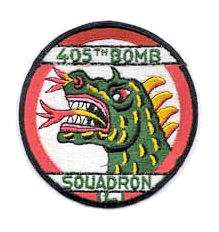405th Tactical Missile Squadron
The 405th Tactical Missile Squadron ("Green Dragons") is an inactive United States Air Force unit. It was last assigned to the 38th Tactical Missile Wing, based at Sembach Air Base, West Germany. It was inactivated on 25 September 1966.
| 405th Tactical Missile Squadron | |
|---|---|
 Emblem of the USAFE 405th Tactical Bombardment Squadron | |
| Active | 1942–1966 |
| Country | United States |
| Branch | United States Air Force |
| Role | Tactical Missile |
| Part of | United States Air Forces in Europe |
| Nickname(s) | Green Dragons |
| Engagements | World War II |
| Commanders | |
| Notable commanders | Ralph Cheli |
History
Activated in early 1941 by the Army Air Corps as a medium bomber squadron during the pre-war mobilization by the United States. Performed coastal patrols as part of First Air Force with B-18 Bolos and early-model B-26 Marauders.
Deployed to Australia in early 1942 to reinforce Fifth Air Force after its withdrawal to Australia. Re-equipped with B-25 Mitchell medium bombers and flew missions from Northern Queensland over New Guinea. Moved to forward airfields in New Guinea and followed MacArthur's advance along the northern coast of the island into the Netherlands East Indies flying tactical bombardment missions against Japanese strong points and airfields. Moved to Luzon, Philippines, as part of the United States liberation forces in 1945, then moved to Okinawa during the summer in preparation for the Invasion of Japan. Moved to Japan and became part of the Occupation Forces. Inactivated in 1949 due to budget reductions.
Reactivated in France in 1953 as a NATO B-57 light bombardment squadron, equipped for night bombardment with nuclear weapons. Moved to West Germany in 1958 as a MGM-1 Matador tactical missile squadron when the unit was ordered out of France. Remained as a tactical missile unit until 1966 when the Mace was retired.
Lineage
- Constituted 15th Reconnaissance Squadron (Medium) on 20 November 1940
- Activated on 15 January 1941
- Redesignated: 405th Bombardment Squadron (Medium) on 22 April 1942
- Redesignated: 405th Bombardment Squadron (Light) on 6 May 1946
- Inactivated on 1 April 1949
- Activated on 1 January 1953
- Redesignated: 405th Bombardment Squadron (Tactical) on 1 October 1955
- Redesignated: 405th Tactical Missile Squadron on 18 June 1958
- Organized on 18 June 1958, assuming personnel and equipment of 69th Tactical Missile Squadron
- Activated 25 September 1962
- Inactivated 25 September 1966
Assignments
- 38th Bombardment Group, attached on 15 January 1941; assigned 25 February 1942 – 1 April 1949, 1 January 1953
- Associated with: 1st Photographic Group, 10 Jun 1941-22 Apr 1942 (training)
- 38th Bombardment Wing, 8 December 1957
- 586th Tactical Missile Group, 18 June 1958
- 38th Tactical Missile Wing, 25 September 1962 – 25 September 1966
Stations
|
|
Dispersed Matador/Mace missile locations
- Site V "Pot Fuse" - 7.0 miles (11.3 km) ESE of Hahn AB 49°54′48″N 007°24′46″E
- Abandoned since 1961. Shelters torn down, site very obscured by trees and other vegetation in thick woodland area.
- Site VI "Heroin" – 9.7 miles (15.6 km) NE of Hahn AB 50°02′37″N 007°25′32″E
- After 405th TMS left this site was transferred to US Army and converted into a Nike-Hercules Air Defense missile site; operational 1970–1979. The area was transferred back to USAF in 1982 and was converted again; this time into a Cruise missile Ground Alert Maintenance Area. The 38th Tactical Missile Wing became operational with its BGM-109 Gryphon cruise missiles at this location 1985 and was inactivated 1991 after the signing of the INF treaty.
Aircraft and missiles
|
|
See also
References
![]()
- Maurer, Maurer, ed. (1983) [1961]. Air Force Combat Units of World War II (PDF) (reprint ed.). Washington, DC: Office of Air Force History. ISBN 0-912799-02-1. LCCN 61060979.
- Maurer, Maurer, ed. (1982) [1969]. Combat Squadrons of the Air Force, World War II (PDF) (reprint ed.). Washington, DC: Office of Air Force History. ISBN 0-405-12194-6. LCCN 70605402. OCLC 72556.
- U.S. Air Force Tactical Missiles, (2009), George Mindling, Robert Bolton ISBN 978-0-557-00029-6
.svg.png)